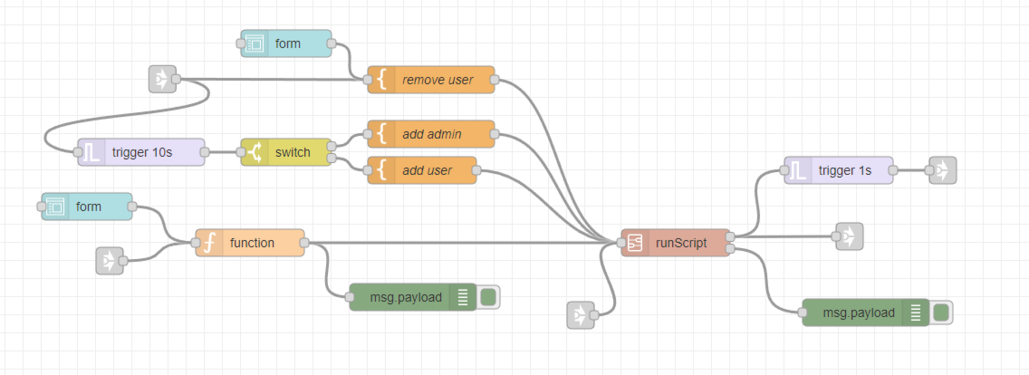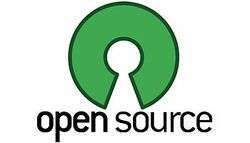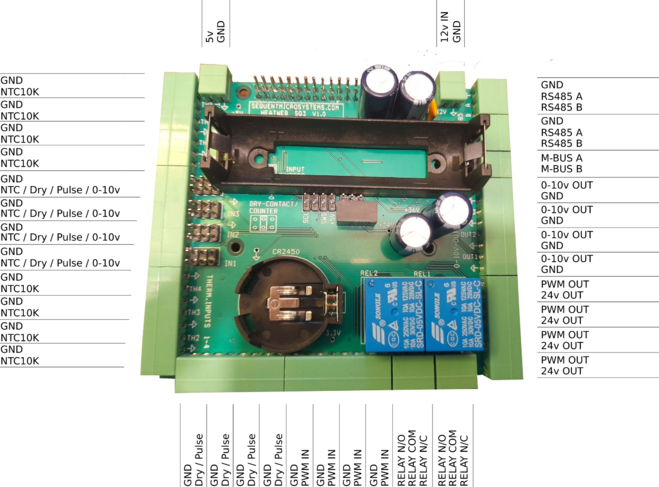Difference between revisions of "Main Page"
| Line 14: | Line 14: | ||
Anyone can make use of the material on this site. | Anyone can make use of the material on this site. | ||
'''To guarantee interoperability between systems,''' all open software used on this site makes use of a standard MQTT protocol as described at '''''[https://github.com/heatweb/heat-network https://github.com/heatweb/heat-network.]''''' Making use of a similar topic structure on all MQTT connected equipment and systems is the most important goal of this project. If everyone can settle on the same 'dictionary' structure, then everything can talk to everything, and software functions can be developed that will be compatible with all systems. The topic structure includes enough topic levels to describe any topology, identify routes, group fields, and allows for complete customisation when it comes to function. We can also integrate with other systems using flatter data structures based on field names alone by giving them a data group of their own. An example of this may be SAP PCDB data, which would be given a data group of ''pcdb'' with key names as set in the PCDB specifications. | '''To guarantee interoperability between systems,''' all open software used on this site makes use of a standard MQTT protocol as described at '''''[https://github.com/heatweb/heat-network https://github.com/heatweb/heat-network.]''''' Making use of a similar topic structure on all MQTT connected equipment and systems is the most important goal of this project. If everyone can settle on the same 'dictionary' structure, then everything can talk to everything, and software functions can be developed that will be compatible with all systems. The topic structure includes enough topic levels to describe any topology, identify routes, group fields, and allows for complete customisation when it comes to function. We can also integrate with other systems using flatter data structures based on field names alone by giving them a data group of their own. An example of this may be SAP PCDB data, which would be given a data group of ''pcdb'' with key names as set in the PCDB specifications. | ||
Collaboration on producing this site is open to anyone with related technical material to contribute in relation to the projects listed. Please contact [[User:Rhg|the admin]] with your intent, and please do not edit other people's work. Any additions that do not specifically contribute technical material related to lowering carbon may be removed without notice, as will any commercially sensitive material or advertising of products or services not directly related to projects. Refer to [[Creating new pages on this Wiki|''Creating new pages on this Wiki'''''.''']] | Collaboration on producing this site is open to anyone with related technical material to contribute in relation to the projects listed. Please contact [[User:Rhg|the admin]] with your intent, and please do not edit other people's work. Any additions that do not specifically contribute technical material related to lowering carbon may be removed without notice, as will any commercially sensitive material or advertising of products or services not directly related to projects. Refer to [[Creating new pages on this Wiki|''Creating new pages on this Wiki'''''.''']] | ||
Revision as of 14:54, 26 May 2022
Introduction
This is a new wiki site, started in May 2022, devoted to open source controls in the HVAC industry with a view to reducing carbon emissions.
The site has been setup following our success with an Innovate UK funded project to look for digital solutions to net zero... https://www.ukri.org/news/new-open-digital-solutions-to-speed-up-the-energy-revolution/
This site runs on a Google Compute VM, alongside Node-RED and open controls software. It acts as a demonstration platform for how a wiki site can be integrated with controls. (if asked to login, use guest / guest)
Anyone can make use of the material on this site.
To guarantee interoperability between systems, all open software used on this site makes use of a standard MQTT protocol as described at https://github.com/heatweb/heat-network. Making use of a similar topic structure on all MQTT connected equipment and systems is the most important goal of this project. If everyone can settle on the same 'dictionary' structure, then everything can talk to everything, and software functions can be developed that will be compatible with all systems. The topic structure includes enough topic levels to describe any topology, identify routes, group fields, and allows for complete customisation when it comes to function. We can also integrate with other systems using flatter data structures based on field names alone by giving them a data group of their own. An example of this may be SAP PCDB data, which would be given a data group of pcdb with key names as set in the PCDB specifications.
Collaboration on producing this site is open to anyone with related technical material to contribute in relation to the projects listed. Please contact the admin with your intent, and please do not edit other people's work. Any additions that do not specifically contribute technical material related to lowering carbon may be removed without notice, as will any commercially sensitive material or advertising of products or services not directly related to projects. Refer to Creating new pages on this Wiki.
If you have a new project and you wish to collaborate, please contact us.
Purpose of this Wiki
- To provide instruction manuals for project related open source hardware and software
- To establish open standards for data labelling and communication (HVAC-MQTT dictionary)
- To establish open standards for equipment control at a software level
- To record processes, procedures and software functions
- For the recording and dissemination of data from field trials related to open technologies and zero-carbon
- To store any media and data that is useful for open-source control
- To provide links to web sites including related GitHub projects
- To demonstrate and experiment with how a wiki can be run alongside controls software acting as a customisable front end
- To demonstrate and experiment with how a wiki can be used (alongside real-time data) to create a feedback loop (between designers and users) to improve outcomes
- Saving carbon through collaboration
Current Collaborators
- Thermal Integration Ltd. (Heatweb)
- Equans (Engie)
- Swansea University
- UCL (University College London)
- Specflue
- Putney Plaza Management Group & Residents' Committee
Projects
The following projects and field trials are the focus of this wiki. Hardware and software is been improved to ensure outcomes meet expectations, with the wiki used as a knowledge base for collaboration.
| Project Title | Description | Links |
|---|---|---|
| Open Source Plumbing Controller | One of six projects awarded funding by Innovate UK to develop new open software, hardware and data solutions that can help accelerate the UK’s transition to a net zero energy system.
Our project concerns developing an open-source controller for heating, ventilation and air conditioning (HVAC) systems that can carry out a wide variety of roles, and be built on and adapted by others. This will allow HVAC systems to be upgraded to open control, and:
|
|
| Specflue Training Centre Refit | Specflue run the UK's largest renewables training centre with lots of low carbon heat sources to be controlled.
The project involves the upgrade of existing controls to use the new open controls standards. |
|
| Swansea University, Solar Heat Energy Demonstrator (SHED) | The Solar Heat Energy Demonstrator in Margam is used to trial two large-scale solar heat storage demonstrators. It is a 1990’s industrial unit that has been retrofitted with solar technology, and as a result, has been running without gas since 2012. The SHED is also home to two other major projects: Transport for Wales’ Active Train Shelter and a test-rig to analyse five commercially available PV and solar thermal technologies.
The project involves the upgrading of the SHED to run on CO2 heat pumps alongside existing solar thermal, providing hot water and driving numerous workspaces with central heating provided by a range of methods, with a view to discovering and documenting best practices. |
|
| Putney Plaza | Putney Plaza is a residential development in South London using gas boilers, CHP and roof mounted air source heat pumps.
The project involves the upgrading of heat pump and chp controls to bring them back online. Residents and management will be provided with an online dashboard to keep track of performance and efficiencies. |
|
| Sandbox Demo | An sandbox project, purely for experimenting and demonstration of technologies. Use this project to test out wiki features and see examples of how data can be presented on pages. |
Primary Applications
Buffer & Thermal Store Controller
Every heating or hot water system that involves renewable energy requires storage, be it a hot water cylinder in a dwelling, or a buffer store in a heat network.
This application follows the current guidance, including CP1 Codes of Practice, and industry best practices, to deliver a buffer control solution.
Functions:
- Buffer and pipe temperature and pressure sensing
- Bivalent control with storage zoning
- Multiple store control with service mode
- Boiler (gas and biomass) and heat pump sequencing, rotation and modulation based on store depletion (as per CP1)
- Solar thermal control
- Overheat functions for biomass and solar systems
- Low storage override functions (shedding of non-critical loads)
- MQTT services, dashboards and remote monitoring
HIU Monitoring and Controls Refurbishment
This application makes use of open-source controls to add monitoring to existing HIU installations, and also to allow controls to be upgraded to comply to best practices and achieve lower return temperatures.
Fan Coil Monitoring and Control
With a significant number of fan coil units and convector heaters out there connected to heat networks, it is important to get a grip on performance and to implement a better standard of controls.
This project application provides both monitoring and valve control to achieve lower return temperatures and manage outputs to better match loads.
This application extends to the monitoring and control of heat pumps and associated three port valves.
Heat Network Management
This application demonstrates how other applications can combine to form larger more complex networks and their control mechanisms.
This is a cloud or panel based installation of the open controls software, pulling together the data from devices to provide remote management and alarm routing.
Data Applications
Saving data of value is one of the most important functions missing from the current zero-carbon landscape. How can we learn if we don't record.
As part of this project we aim to provide software functions to save and retrieve data from a variety of data sources, with the aim of providing permanent records that can be used in academic study and referred to in guidance.
Combining data storage with alarm routing, allows system problems to be better diagnosed and fixed.
Data Storage
Methods for storing data.
Alarm Routing
Once a project is complete, handed over and all working, the most important function is alarm routing. You need to know when something goes wrong and required intervention.
Alarm routing is at the core of fit-and-forget plumbing, or a reliable heat network, however the implementation of a robust alarm system is difficult. In many cases, alarm systems end up being ignored due to an excessive number of low priority alarms.
We cover the most common methods of communicating alarms to individuals or organisations, as well as the methods used to prevent 'alarm overload' and how to escalate and redirect alarms when not responded to.
Hardware
The primary controls hardware used in this project is the Heatweb BEMS Hat for the Raspberry Pi (or BeagleBone).
This is a general purpose I/O board providing a full suite of inputs, outputs and communication buses for use in the HVAC industry. Combined with Node-RED the board offers a complete open-source controls solution for all common equipment.
The boards run from a 12v dc supply, generating 5v for the board, 24v for valves, and 36v for M-Bus, using on-board dc-dc converters backed up by a rechargeable battery for uninterrupted power supply. A coin cell is used to power a real-time clock.
The I/O includes:
- NTC or 0-10v temperature and pressure sensors
- Pulse flow sensors and meters
- Volt-free signals from relays
- Relay outputs
- PWM inputs and outputs for valves and pumps
- 0-10v outputs for pumps, valves and boilers
- RS485 for Modbus communications with pumps, boilers, HIUs and BMS systems
- M-Bus meter communications
WiFi, Ethernet and Bluetooth are provided by the Raspberry Pi board.
A number of the inputs are universal, and can be switched between NTC, 0-10v, or volt-free / pulse inputs (jumper selected). This ability to alter the hardware setup increases versatility significantly.
The addition of M-Bus allows us to connect to heat meters as standard, making the board a stand alone solution to open-sourcing meter data, and to use meter data within control logic.
The battery backup allows us to safely shut-down all valves and the controls when power is removed. This overcomes a common problem with HVAC systems, where valves typically remain open, destroying network performance.
Software
The following links relate to software used in projects on this wiki.
Please Help
We need help in this project with the following:
- We are looking to recruit a skilled software engineer, capable of developing in Node.js and Linux embedded systems.
- We need to recruit keen engineers who wish to become one of the next generation of open-source controls installers.
- We are looking for properties to participate in field trials, where we can upgrade radiator controls and monitor performance through next Winter.
- We would like to talk to local authorities with residential blocks that have a roof space for a heat pump and wish to perform trials, or have energy centres that they would like to gain transparency on with a view to future zero-carbon upgrades.
We also have some functions we would like to build into open libraries but currently lack the knowledge to achieve properly. Help would be appreciated:
- Bluetooth App that runs on IoS and Android, linking forms and web pages generated from Node-RED templates to App to enable user interfaces to be entirely driven from Node-RED. Working prototype version exists for Android using MIT App Inventor 2.



